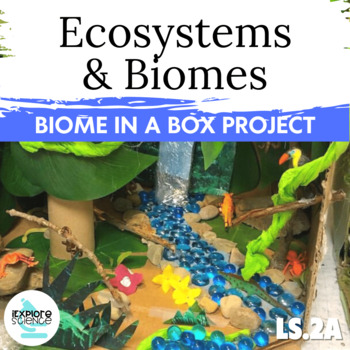Ecosystems & Biomes Project Based Learning + Text - Biome In A Box NGSS LS.2A
- Zip
Also included in
- In Solar Energy In The Desert, students will examine a debate unfolding in the Mojave Desert — should solar farms be installed in delicate desert ecosystems? — in order to develop an understanding of natural resources, including renewable solar energy, and the factors that influence climates. This SPrice $50.00Original Price $84.00Save $34.00
Description
Wrap up learning about biomes and ecosystems with this engaging project-based learning assessment that incorporates environmental interactions, biotic and abiotic factors, resource availability, and interactions in ecosystems.
Students are tasked with creating a model for the Ecosystems Around The World exhibit at a local museum. In this project, students:
- read and interpret texts
- carry out research
- demonstrate their understanding of biotic and abiotic factors, resource availability, and interactions within ecosystems
- expand their understanding of the impact of human activity on ecosystems and their functioning
Learning Targets:
- Students will develop a model to demonstrate their understanding of environmental interactions between and among living and non-living things in ecosystems.
- Students will develop a model to demonstrate their understanding of the characteristics of Earth’s terrestrial biomes.
This lesson includes:
- 10 student pages
- Human Impacts In Earth’s Biomes interactive text (17 pages + answer key)
- Biome Snapshot Cards (14 pages)
- detailed teacher lesson guide (3 pages)
- answer keys + rubric
How can this lesson be used?
- launch student learning into Earth’s biomes (present the project task and then begin the investigation!)
- assess student understanding of biomes and/or ecosystems
- extend student learning through an engaging, collaborative task
How much class time will this take?
- This activity can be completed within 2-3 classes -- at least one class for research and a second class for project construction.
Is this NGSS-aligned?
This resource is part of a storyline designed to work toward the tagged Next Generation Science Standards. Because Performance Expectations are designed to assess learning by the end of the grade band, unit material may not fully assess every Performance Expectation tagged in the post.
Explore the complete Solar Energy In The Desert, which focuses on the intersection between climate and living communities, or access through the Spark Subscription.
This activity assesses student mastery of the Disciplinary Core Ideas, Science and Engineering Practices, and/or Crosscutting Concepts in the tagged Performance Expectations.
- Disciplinary Core Idea: LS2.A.1 Organisms, and populations of organisms, are dependent on their environmental interactions both with other living things and with nonliving factors.
This activity engages students in the following Science and Engineering Practices:
- Obtaining, Evaluating, and Communicating Information
- Developing and Using Models
This activity encourages students to think about the following Crosscutting Concepts:
- Systems and System Models
- Cause and Effect
Can I see an example of how you structure your lessons and student materials?
Download my Let's Talk Trash Anchor Phenomenon freebieHERE</a>!
What if I have questions?
You can email me at nvantassel@iexplorescience.com with questions about resources or implementation. I'm happy to help!
Check Out These Related Resources
- Changes In Ecosystems -- Data Analysis Lab and CER Writing Task (NGSS MS-LS2-4)
- Biotic and Abiotic Factors -- 5E Activity Bundle (NGSS MS-LS2-4)
- Project Based Learning: Invasive Species Project
- Activity Pack: Field Notes Food Web
- Activity Pack: Where Have All The Tree Frogs Gone? Mystery
- Biomes -- 5E Unit Plan (NGSS MS-LS2-1) BUNDLE
- Solar Energy In The Desert - Climate, Desert Ecosystems, & Energy Resources BUNDLE
This activity bundle is part of a complete unit storyline that works towards these standards:
- MS-LS2-1 Analyze and interpret data to provide evidence for the effects of resource availability on organisms and populations of organisms in an ecosystem.
What Other Teachers Are Saying
⭐️ “Great culminating activity for our biome unit. This PBL had everything needed, including a scoring rubric- my students appreciated that.”
⭐️ “My students were thoroughly engaged and loved it!”
Terms Of Use:
Copyright © 2018, 2022 iExploreScience LLC. All pages of this product are copyrighted, and all rights are reserved by the author. You may not create anything to sell or share based on this packet. The product is created for the use of ONE teacher. Please do not share with colleagues. If they like the product, please send them to my TpT store. I appreciate your support with this request! You are permitted to share ONLY the cover image of this product on your blog or via social media as long as you link back to my product on TpT. Failure to comply is a copyright infringement and a violation of the Digital Millennium Copyright Act (DMCA). Clipart and elements found in this PDF are copyrighted and cannot be extracted and used outside of this file without permission or license. Intended for classroom and personal use ONLY.
*Note: NGSS is a registered trademark of Achieve. Neither Achieve nor the lead states and partners that developed the Next Generation Science Standards were involved in the production of this product, and do not endorse it.






